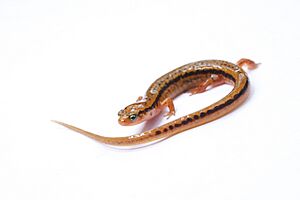Blue Ridge two-lined salamander facts for kids
Quick facts for kids Blue Ridge two-lined salamander |
|
|---|---|
 |
|
| Conservation status | |
| Scientific classification |
The Blue Ridge two-lined salamander (Eurycea wilderae) is a small salamander found only in the United States. It lives in the southern Appalachian Mountains, mostly south of Virginia. A similar salamander, Eurycea bislineata, lives further north.
This salamander belongs to a group called Eurycea, which has 33 different species. Some of these salamanders change from a water-living larva to a land-living adult. Others stay in their larval form their whole lives.
Adult Blue Ridge two-lined salamanders often live near stream banks. Their young, called larvae, live in streams and wet areas. Their natural habitats include cool forests, rivers, and freshwater springs. Sadly, they are sometimes threatened by habitat loss. This species is named after Inez Whipple Wilder, a zoologist who studied Eurycea salamanders. The IUCN lists these amphibians as a species of "least concern." This means they are not currently in danger of extinction.
Contents
What They Look Like
The Blue Ridge two-lined salamander is about 7 to 10.7 cm (2 3/4 to 4 1/2 inches) long. Their color can be bright yellow, yellow-orange, or orange. They have two black lines along their back. These lines usually break into dots or blotches near the middle of their tail. You might also see scattered black dots on their back.
This salamander has a long tail. It makes up about 55-60% of their total body length. They usually have 14 to 16 grooves on their sides, called costal grooves. Salamanders living at lower elevations often have 14 grooves. They also have small grooves between their nostrils and upper lip, called nasolabial grooves.
How They Reproduce
Blue Ridge two-lined salamanders reproduce using external fertilization. This means the eggs are fertilized outside the female's body. Females usually lay their eggs in late winter or early spring. They place the eggs under rocks, logs, or leaves in the water. The female then guards her eggs until they hatch.
When the eggs hatch, the young salamanders are called larvae. They have external gills and live completely in the water for about two years. After this time, they change into adults. This change is called metamorphosis. When they metamorphose depends on the water temperature and how much food is available. Warmer temperatures can make them change sooner. More food helps them grow larger before they change.
There are two types of male Blue Ridge two-lined salamanders. Some are "searching males." They have special features like cirri (small projections near the nostrils) and glands that help them find and attract females on land. Other males are "guarding males." They have stronger jaw muscles. These muscles help them defend females at their nesting sites in the water.
Where They Live
Blue Ridge two-lined salamanders are found in the southern Appalachian Mountains. They live along streams and in forested areas. Their habitat changes depending on the mating season. During mating, they might be found more in water. At other times, they are more on land.
These salamanders do not have lungs. Because of this, they need moist and cool places to live. Streams that are good for them have submerged rocks or logs where they can lay eggs. When they are not breeding, they often burrow under logs and leaf litter. In good habitats, you might find more than 100 of these salamanders in just one square meter!
What They Eat
The diet of the Blue Ridge two-lined salamander is like that of other land-living salamanders. Both the young (aquatic juveniles) and the adults eat small creatures. They eat tiny crustaceans called copepods, midge larvae, and worms called nematodes. They also eat both aquatic and land insects. The size of their prey depends on the salamander's own size and how fast it is growing.
Prey Items
Adult Blue Ridge two-lined salamanders mainly eat creatures that live on land. These include non-insect arthropods, worms, and some marine invertebrates. The larvae mostly feed on small aquatic insects and other water-living invertebrates. They also eat some land insects that fall into the water.
Who Eats Them
Larger salamanders, like spring salamanders and black-bellied salamanders, sometimes eat Blue Ridge two-lined salamanders. Garter snakes also prey on both the larvae and adult salamanders. Adult salamanders can use their sense of smell to detect predators. However, studies have shown that even when predators are nearby, these salamanders do not always use rocks for cover.
How They Behave
Stream salamanders, like the Blue Ridge two-lined salamander, often spread out in different areas. This helps them avoid competing for food and being eaten by predators. One study looked at the choice between staying moist and avoiding predators. It found that Blue Ridge two-lined salamanders often stayed about 15–20 meters away from the stream edge. This meant they risked drying out because the environment was drier. However, they chose this drier spot to avoid possible predators closer to the water. Their size often plays a role in how they compete with other salamanders.


